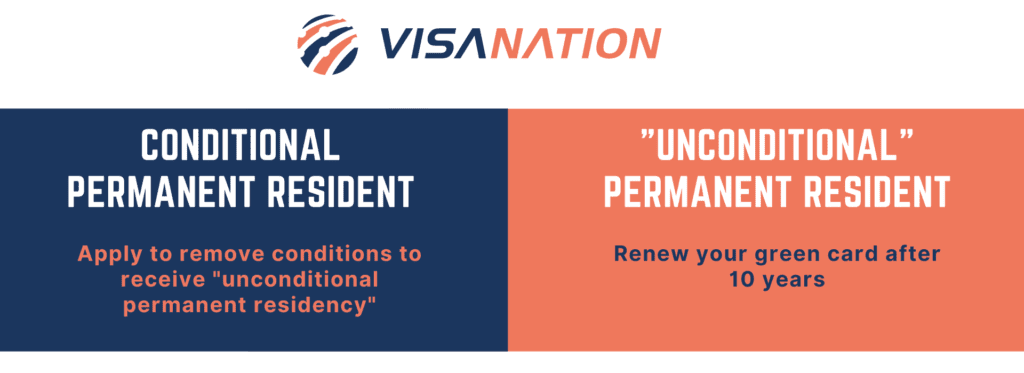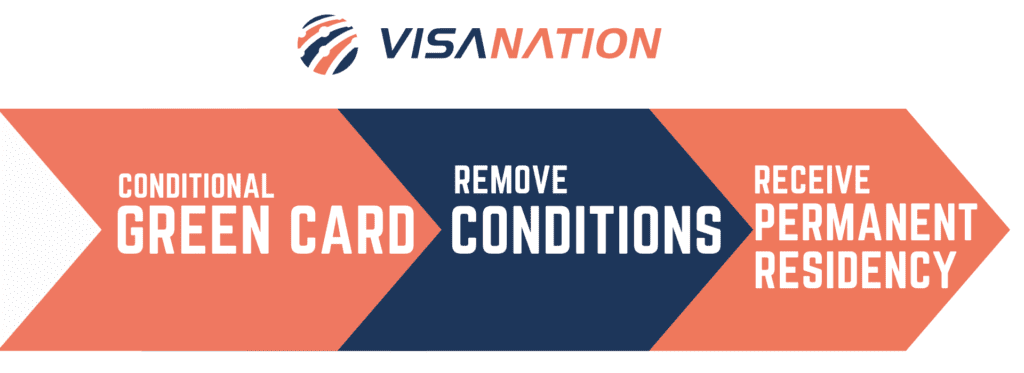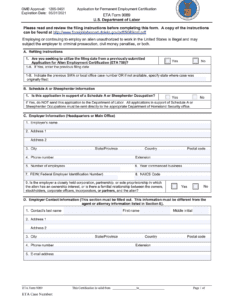Top 5 Things Conditional Permanent Residents Should Know
Conditional permanent residence can be a mandatory immigration step for some foreigners planning on residing in the U.S. It is essential that you are aware of all of the benefits and limitations that conditional green card status comes with and its effects on your family. On this page, you will learn all about this temporary green card, the meaning of this residence status, and how to make the upgrade to a permanent green card.
1. What is Conditional Permanent Residence?
A conditional green card provides foreign citizens with a limited residency in the U.S., which is subject to certain conditions. If those conditions are fulfilled, then the foreign citizen will gain unconditional permanent residency in the U.S. Conditional permanent residency is issued by the USCIS only to certain types of immigrants.
Firstly, if you are in the process of obtaining a green card through marriage and you have been married to your spouse for less than two years, then you will be subject to a conditional permanent residency.
Secondly, if you are a qualified EB-5 investor, you will be issued a conditional green card. If the foreign investor satisfies his EB-5 requirements, then they are eligible to apply to remove conditions on their green card.
2. Difference Between Permanent Resident and Conditional Permanent Resident
The key difference between a permanent resident and a conditional permanent resident is that the latter has specific restrictions placed on their residency status. One of the biggest distinctions between the two is the “testing period” that is placed on conditional permanent residents. The period lasts two years, during which you must fulfill the conditions of your stay.
3. Purpose of Conditional Residency in the U.S. Immigration Framework
When looking at the reason why only certain types of visa applicants are subject to conditional residency and others are not, there are several reasons for this.
In recent years there has been a global rise in fraudulent marriages and the U.S. has been particularly affected by it. For this reason, the U.S. treats marriages that are under 2 years as prime suspects for marriage fraud. On the other hand, under U.S. immigration law, if your marriage is over 2 years long you’re your foreign spouse will benefit from unconditional permanent residency. This difference is most prominent in the distinction between CR-1 visa and IR-1 visa.
In terms of investment conditional green card, EB-5 is the only U.S. visa that allows foreign entrepreneurs to “invest” their way to permanent residency. Considering the restrictive approach of U.S. immigration, it is understandable that the nation is very attentive to individuals that are willing to invest large sums of money in return for a green card. EB-5 is not a way to buy American citizenship, it is a pathway to attract appropriate foreign investment to specific locations around the country.
4. How to Remove Conditions on Residence
The process of removing conditions for a conditional green card holder varies depending on their residency status.
For immigrants that obtained their conditional permanent residency (CR-1visa) through marriage, the couple must apply together to remove conditions 90 days before the second anniversary of acquiring conditional residency in the U.S. You must fill out and submit Form I-751 and upon approval, the conditions on your green card will be removed.
EB-5 investor visa holders must submit Form I-829, which, if approved, would result in the removal of conditions on their permanent residency. The investor must prove that they have fulfilled the requirements of their I-526 petition in their I-829 submission. Investors must submit the required evidence to support their claim that they have fulfilled the investment requirements.
5. Consequences of Not Remove Conditions on Conditional Green Card
Individuals that do not remove conditions on their green card within the required time period can be subject to removal or deportation proceedings. When your visa expires and you have not filed for removal of conditions you are essentially being unlawfully present in the U.S. Not only may the government begin to actively deport you, if you are removed from the country, you can be banned from entering the U.S. for several years. Any immigration offenses that you incur will automatically affect all of your future U.S. immigration applications. It is crucial to comply with the regulations and apply to remove conditions on your conditional permanent residency on time.
Frequently Asked Questions: Conditional Permanent Residency
Below you will find answers to the most commonly asked questions about conditional green cards.
Who gets a 2-year conditional green card?
You will receive a conditional green card if you have been married to your U.S. spouse for less than two years. The conditions on your permanent residency will last for two years and you will have to jointly apply with your spouse to remove the conditions. You must apply 90 days before the two-year anniversary of your receiving your conditional permanent residence. If your application is successful, you will then receive a 10-year green card that can be freely renewed.
How long does it take to get a permanent green card from a conditional green card?
If you are a spouse of a U.S. citizen, it will take approximately 16 months to go from a conditional green card to unconditional permanent residency. The wait time depends on the processing speed of I-751, which is usually between 13 months and 19 months.
If you are an EB-5 visa investor, then it would be around 25 months for you to make the switch from a temporary green card to permanent residency. Your wait time will depend on the processing speed of I-829, which is generally 25 months to 40 months.
While your I-751 or I-829 is processing, you are allowed to legally reside in the U.S., which means that you will not be deported and removal proceedings will not be initiated against you. Your conditional permanent residency will continue until you receive the outcome of your I-751 or I-829, be it negative or positive.
Are conditional permanent residents eligible for U.S. citizenship?
Conditional permanent residents that remove conditions on their green card can become U.S. citizens. The application for citizenship, N-400, is a separate process that you must be eligible for. Depending on your immigration pathway, you can apply for naturalization after certain years of receiving your permanent residency, which is anywhere from 3 to 5 years. If you have lived in the U.S. under a conditional green card, your years residing in the country will count towards the time requirements needed to obtain U.S. citizenship.
Can I work on a conditional green card?
Conditional green card holders are eligible to work in the U.S. for any employer. You do not need to obtain work authorization for each employer that you want to work for. Essentially, you can exercise the same employment rights and seek the same employment opportunities as any U.S. citizen.
Can I travel on a conditional green card?
Conditional permanent residents can easily travel outside of the U.S. They do not need to apply for any approval to leave or enter the country again if you are planning on remaining outside of the U.S. for less than 12 months or 180 consecutive days.
However, you can still abandon your green card by staying outside the country for more than 12 months or 180 consecutive days. If you plan on traveling for more than 1 year, you will have to apply for a re-entry permit, which would allow you to avoid green card abandonment.
If you fail to apply for a re-entry permit, you will have to reinstate your green card. This will involve applying for a returning resident (SB-1) immigrant visa. If your SB-1 is rejected, you will have to either apply for a new green card or apply for a nonimmigrant visa, whichever suits your plans.
It is important to note that the USCIS may not count the years of your conditional residence for the naturalization application if you do not comply with the travel requirements.
Can I renew my conditional green card?
Conditional green cards cannot be renewed at any point during your residency in the U.S. If the conditions are not removed by submitting I-751 or I-829 within the appropriate timeframe, you will forfeit your permanent residence.
The conditional residence is given to certain individuals as part of the “testing” period. Thus, it is expected for these individuals to comply with the requirements to prove to the U.S. government that they are eligible for unconditional permanent residence. One of the ways that they can do so is to comply with immigration regulations and apply to remove conditions on time.
Can children of conditional green card holders come to the U.S.?
Conditional permanent residents are eligible to bring their children to the U.S. When you receive the green card, you can file Form I-130. In fact, you can file the form at any time after receiving your conditional permanent residence.
Can I lose my conditional green card if I get divorced?
It is possible to lose your conditional green card after divorce and even become ineligible to apply for unconditional permanent residency. It is crucial that you become familiar with the necessary regulations and comply with the requirements. The process and evidence will vary dramatically depending on at which point in your immigration journey divorce took place.






